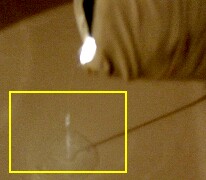 Page Two Here is a simple experiment you can do to illustrate sending light through a pipe.   In our experiment, the pipe will be a stream of water.
You'll need a flashlight, some thick tape, a baby food jar, and some water. You'll also need a hammer and nail to poke two holes in the jar lid. In our experiment, the pipe will be a stream of water.
You'll need a flashlight, some thick tape, a baby food jar, and some water. You'll also need a hammer and nail to poke two holes in the jar lid.You can eat the baby food if you want. Personally, we weren't that hungry. Just make sure the jar is empty and clean. 
 Fill the jar with water and put the lid on tightly. Tape the jar to the flashlight with the lid outwards. (The tape is to keep light from escaping from the jar. We used white tape, and had to wrap it many times; duct tape or black electrical tape would be a better choice).
Fill the jar with water and put the lid on tightly. Tape the jar to the flashlight with the lid outwards. (The tape is to keep light from escaping from the jar. We used white tape, and had to wrap it many times; duct tape or black electrical tape would be a better choice). Now use the hammer and nail to poke two holes in the lid, one at the top and one at the bottom. Air will be able to get in the top hole, allowing water to escape through the bottom one. Turn all the lights out, turn on the flashlight, and start to pour the water out of the jar.  You will see some light escaping from the hole. You will also see some light escaping from the stream of water ... it will be visibly lit up. This is light that wasn't reflected internally.
You will see some light escaping from the hole. You will also see some light escaping from the stream of water ... it will be visibly lit up. This is light that wasn't reflected internally.However, what you will also see if you look closely is that the puddle of water that forms at the bottom is also lit up! This happens because some of the light travelling inside the tube of water experienced total internal reflection every time it hit the edge of the water, and wasn't able to escape. It just got bounced back and forth inside the tube of water all the way down to the bottom. What we've just done is sent light down a 'pipe'. Water isn't a very efficient light pipe. A lot of light escaped into the air. If we could somehow send light through a more effective pipe, we could send signals with it. That's what fibre optics does, with glass tubes instead of water. |